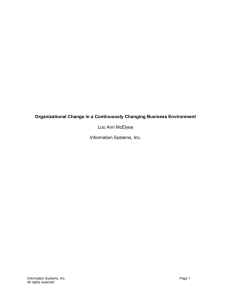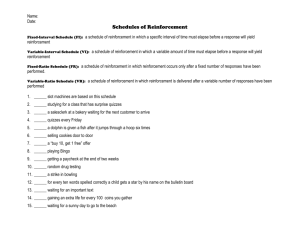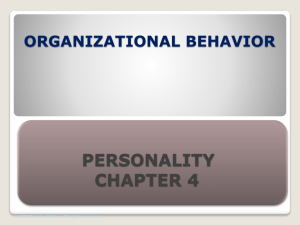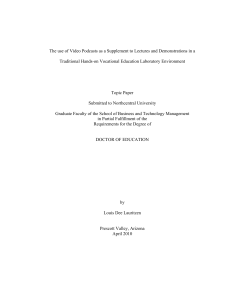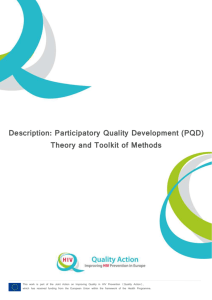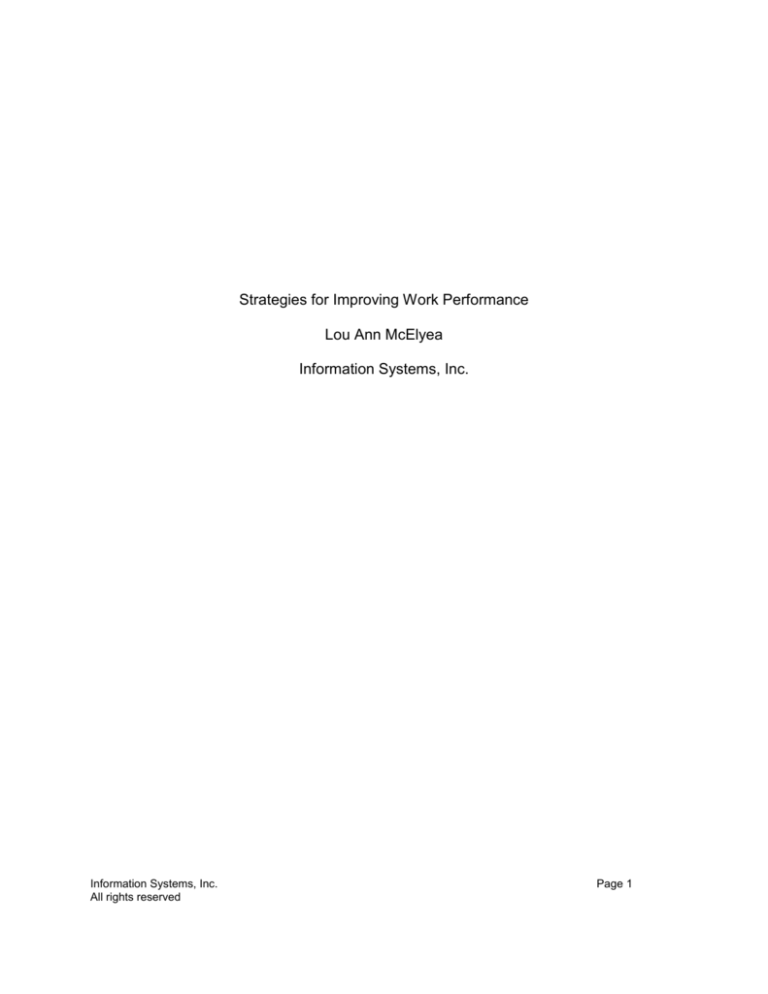
Strategies for Improving Work Performance
Lou Ann McElyea
Information Systems, Inc.
Information Systems, Inc.
All rights reserved
Page 1
Abstract
This paper will focus on some tools that assist the manager in understanding
behavior. Theories and concepts of decision making, problem solving, motivation,
leadership and change to develop strategies for improving work performance will be
explored.
Information Systems, Inc.
All rights reserved
Page 2
Managers can shape employee behavior by guiding their learning in graduated
steps (Robbins, 2005). Each successive step that moves the employee closer to the
desired behavior is rewarded. There are four methods to shape behavior:
1. Positive reinforcement is following a response with something positive.
2. Negative reinforcement is following a response with something negative.
3. Punishment is causing an unpleasant condition to try to force a change in
behavior.
4. Extinction is eliminating any reinforcement of behavior (Robbins, 2005) .
Positive reinforcement is an effective tool in changing behavior even in the most
difficult circumstances. The timing of the reinforcement is very important. Positive
reinforcement should be given soon after the positive behavior to have the maximum
effect. Frequency of positive reinforcement is also important. If positive reinforcement is
given on a daily basis, it will improve productivity on a weekly basis (Strange, 1985).
One method of positive reinforcement is rewarding employees. Effective
managers are able to accomplish their work through and with people. While their job is
to direct, monitor and correct, they also should listen, train, help and reward (King,
1985). Financial rewards immediately come to mind but there are other rewards that
may be more effective in changing behavior. Five areas of rewards within the control of
a manager include:
1. Recognition – determining what is important to an employee
2. Work - that is rewarding itself
Information Systems, Inc.
All rights reserved
Page 3
3. Responsibility – special projects, leadership or development of others
4. Achievement – providing opportunities and setting challenges for
achievable goals
5. Growth – cross-training, seminars, coaching and delegation (King, 1985).
Attitudes are defined as evaluative statements or judgment concerning objects,
people or events (Robbins, 2005). When employees are faced with change, there are
three components of attitude they may display:
1. Cognition – value statements
2. Affect – emotional or feeling
3. Behavior – intention to behave a certain way (Robbins, 2005)
In organizations some key attitudes affect job behavior. Some work related
attitudes are job satisfaction (collection of feelings an individual has toward their job),
job involvement (the degree to which a person identifies with their job, actively
participates in it and considers his/her performance important to self-worth), and
organizational commitment (the degree to which an employee identifies with a particular
organization and its goals and wishes to maintain membership in the organization
(Robbins, 2005). The behavioral responses are outcomes of the cognitive and
emotional reactions (Smollan, 2006).
Personality is defined as the sum total of ways in which an individual reacts and
interacts with others (Robbins, 2005). Understanding employee attitudes and
personality helps the manager determine ways in which they can shape the behavior of
Information Systems, Inc.
All rights reserved
Page 4
employees. The Myers-Briggs Type Indicator (MBTI) is a personality instrument that has
several applications. In the early 1900’s Swiss psychiatrist Carl G. Jung confirmed that
individuals have mental or psychological preferences for performing certain tasks. Two
students of his work were Isabel Briggs Myers and her mother, Katherine C. Briggs who
conducted research in the early 1940’s on how to measure personality preferences
(Kennedy, Kennedy, 2004). The MBTI is a widely used personality test that taps four
personality characteristics and classifies people into one of 16 personality types. People
are classified as extroverted or introverted (E or I), sensing or intuitive (S or N), thinking
or feeling (T or F), and judging or perceiving (J or P). The MBTI is most often used by
managers to provide career guidance to employees and help employees increase self
awareness (Robbins, 2005). The MBTI is used today by outplacement firms that are
contracted by large corporations to find displaced employees new positions. Research
data from the MBTI indicates that different personality types bring different strengths
and potential weaknesses to the job search process (Kennedy, Kennedy, 2004). If the
personality type can be matched with the requirements of job openings, there is a better
chance the candidate will be successful in the new position.
Another behavioral tool is the Rational Decision Making Model which describes
how individuals should behave to maximize some outcome. The steps in the Rational
Decision Making Model are:
1. define the problem
2. identify the decision criteria
Information Systems, Inc.
All rights reserved
Page 5
3. allocate weights to the criteria
4. develop the alternatives
5. evaluate the alternatives
6. select the best alternative (Robbins, 2005)
Certain assumptions must be made to effectively utilize the model:
1. The problem is clear and unambiguous.
2. All relevant criteria and viable alternatives can be identified.
3. Criteria and alternatives can be ranked and weighted by importance.
4. Decision criteria are constant and weights are stable over time.
5. No time or cost constraints.
6. Alternative will be chosen that yields the highest perceived value
(Robbins, 2005).
In summary, the manager who desires to change the behavior of their employees
in a positive manner to improve work performance, has tools available to them. Their
understanding of these tools and effective use of them determines the degree to which
the behavior of employees can be changed. Understanding attitudes, personality, the
value of reinforcing behaviors, and decision making models are just a few of the tools
available.
Information Systems, Inc.
All rights reserved
Page 6
References
Kennedy, R. Bryan & Kennedy, D. Ashley, Using the Myers-Briggs Type Indicator in
Career Counseling, Journal of Employment Counseling, March 2004.
King, Dennis, Rewarding Can Be Rewarding, Supervisory Management, Saranac Lake,
January, 1985,
http://proquest.umi.com.proxy1.ncu.edu/pgdweb/?did=1317757&sid=1&Fmt=2&cl
ientid=52110&RQT=309&VName=PQD
Robbins, Stephen P. (2005), Organizational Behavior, Upper Saddle River, New Jersey,
Pearson, Prentice Hall
Smollan, Roy Kark, Minds, Hearts and Deeds: Cognitive, Affective and Behavioural
Responses to Change, Journal of Change Management, London, June 2006
http://proquest.umi.com.proxy1.ncu.edu/pqdweb/?did=1094306971&sid=18&Fmt=2&clie
ntId=52110&RQT=309&VName=PQD
Strang, T. Scott, Positive Reinforcement: How Often and How Much, Supervisory
Management, Saranac Lake, January 1985
http://proquest.umi.com.proxy1.ncu.edu/pqdweb/?did=7120840&sid=9&Fmt=2&clientId
=52110&RQT=309&VName=PQD
Information Systems, Inc.
All rights reserved
Page 7







